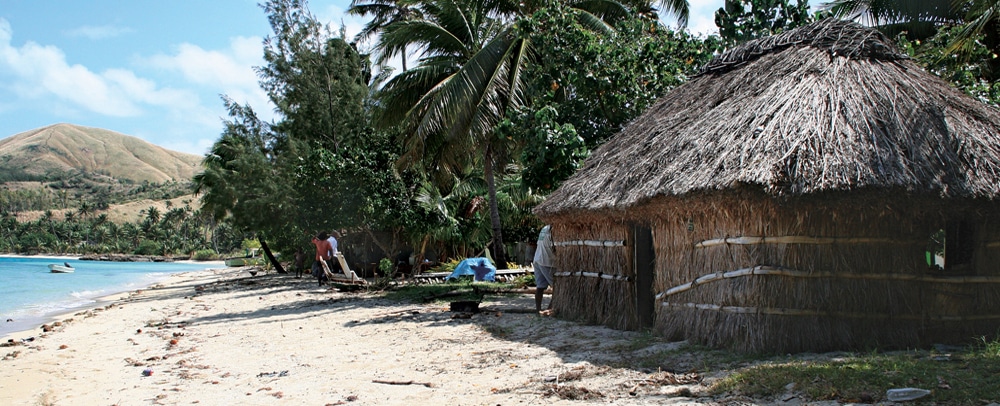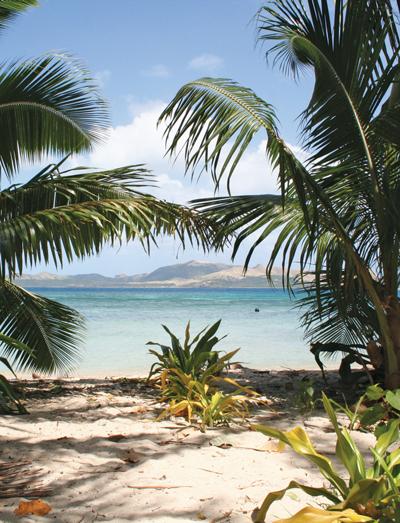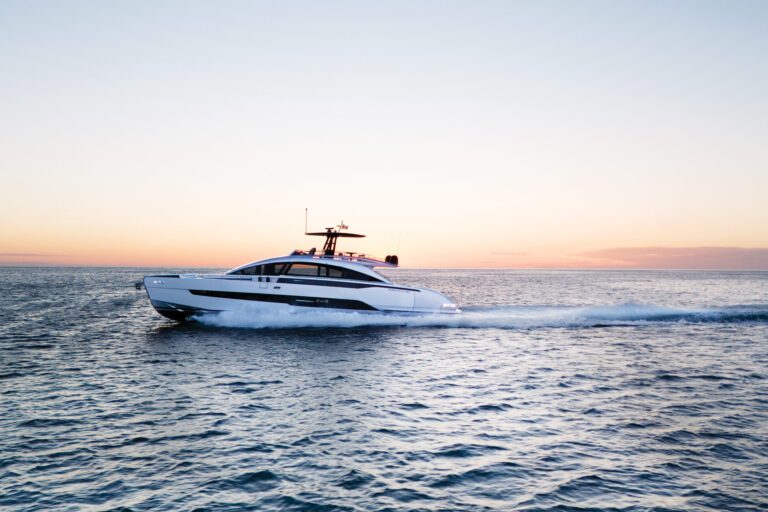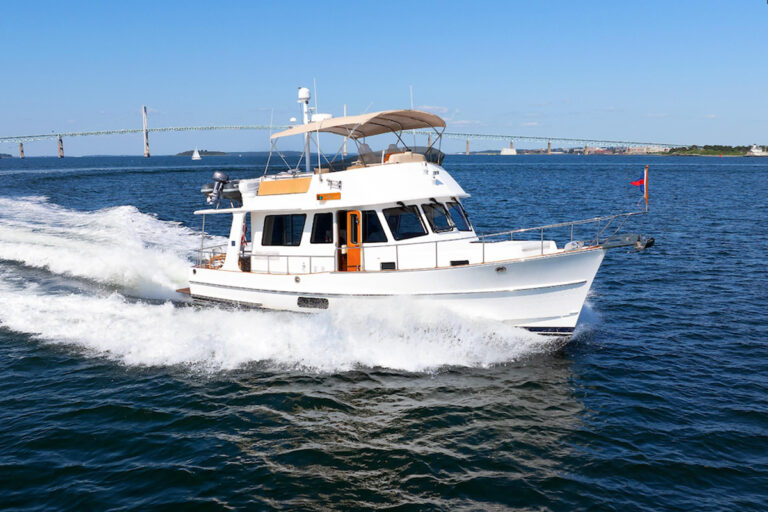
Fiji Charter
I am floating face-down in two-to four-foot swells. Nasty bits of Pacific chop are breaking over my back. My fins are of little help against the cut’s rushing current, so I kick harder — as hard as I can — trying not to choke on the salt spray running down my snorkel and into my throat.
The manta ray’s wingspan is easily 10 feet. Its body is tuxedo black, gliding effortlessly through the deep blue into a storm of white plankton as thick as December snow. I try to keep pace above the ray as it passes over a coral mound the size of a Mini Cooper. Its shadow is ominous, like that of a spaceship overtaking the moon.
A second manta ray enters my peripheral vision from the right, just as big, just as shockingly big. It banks like an aircraft carrier into the current, its mouth stretched open and ready to feed.
There’s an awful lot of plankton between that second ray and me.
It’s not stopping. Or slowing.
Do these things attack? I wonder, briefly assessing the damage I might do with a purple plastic snorkel.
The rays swim on and after a few minutes, I can no longer keep up. I lift my head and look for my ride: a 21-foot Protector with bright-orange tubes and a hardtop that make typical white tenders look like bathtub toys. I toss my gear over the side and slop my dripping-wet feet onto the nonslip sole.
There are no drink holders. No speaker system. No frills. And why, exactly, would I trade safety for frills when I’m chasing 10-foot manta rays through four-foot swells?
“That’s pretty much the owner’s attitude as well,” says engineer Ben Cameron-Saul, who regularly pitches in with deckhand duties aboard the 111-foot Alloy motoryacht VvS1. “The Protector is ideal for the kind of charter program we’re running. For people who like to fish and dive, it really doesn’t get any better.”

My adrenaline is still pumping when the Protector deposits me safely on the afterdeck of VvS1, where, I am pleased to report, there are frills galore. This yacht is a custom one-off developed specifically to bring luxury service and style to off-the-beaten-course destinations like this one: Fiji. VvS1’s exterior paint is an intimidating shark gray, and it occasionally leaves tribal chiefs asking whether she is a military vessel. She has battlewagon-quality bait tanks and freezers built into her cockpit, plus top-of-the-line Shimano gear to support true big-game fishing. Her range is a staggering 4,000 miles at 10 knots, with a fuel burn of no more than 26 gallons per hour. “We’re clean and green,” Capt. Andy Grocott tells me. “We did an eight-day charter earlier this year, and the drinks cost the client more than the fuel.”
Yes, VvS1’s interior is contemporary and beautiful. Nearly floor-to-ceiling windows offer a sparkling view — as befits a yacht built for a jeweler and named for a nearly perfect cut of diamond — but don’t let the cozy leather seats, limed-oak walls and full-size outdoor teppanyaki bar fool you. VvS1 offers the same quality of service you will find from Antigua to Antibes, but she is a far cry from your typical charter yacht.
“There’s nothing wrong with a big white boat, but I’m not a big-white-boat kind of guy,” says Grocott, who oversaw the last eight months of the build before taking command when VvS1 launched in May 2007. “I’m like the boat’s owner. I’m more adventurous. This boat is built for that.”
It’s perfectly outfitted for a destination like Fiji, where VvS1 plans to spend six months each year, alternating with six months in the owner’s native New Zealand. Only a handful of properly crewed charter yachts visit Fiji, let alone make the remote island nation a home base and give their crews time to gather local knowledge. The first international-caliber yacht to settle into these waters was the 115-foot McMullen & Wing Surprise, whose captain had to draw her own charts to establish itineraries as recently as five years ago. That yacht sold to a new owner last year and moved to Tahiti, leaving the premier crewed yacht spot in Fiji for VvS1 to fill.

My charter was at the end of VvS1’s first season, in Fiji’s Mamanuca and Yasawa archipelagos, which are closest to the international airport in Nadi. (You can fly directly into Nadi from Los Angeles, experiencing an 11-hour time change.) The Mamanucas and Yasawas comprise one of several possible itineraries, offering a taste of the country’s fishing, snorkeling, diving and village culture. If you’re serious about scuba, consider the Vanua Levu and Lomaiviti archipelagos. The best surfing is in the Beqa and Kadavu islands, while the Taveuni area offers superb game fishing.
“The areas off to the east are totally different,” says Allan Jouning of New Zealand-based 37 South, which markets VvS1 for charter. “You almost think you’re not in Fiji. I’ve seen rock canyons and pine trees. Fiji is quite diverse.”

Nadi’s airport is the only international option from the States, so if you have just one week, the Mamanucas and Yasawas are easiest to access. Fiji is big — getting to the other archipelagos can add two hours to your 10-plus-hour flight from Los Angeles — so for the out islands, think about a 10-day or two-week charter. Acclimation to the time zone will consume a day or two, making a day at a hotel worth considering before boarding VvS1. Several resorts are on the purpose-built, tourist-friendly Denarau Island about 20 minutes from the airport. I found the Sofitel Fiji Resort Spa perfectly suitable for a day of rest by the pool. For fewer crowds, hop a ferry to Musket Cove Yacht Club, which offers tiki-style bungalows and naturally formed beaches.
The best experiences, though, are found when you head out aboard VvS1. The farther you cruise from Nadi, the more authentic the islands become. We spent one afternoon on Nacula Island in the Yasawas, at a village overlooking Malakati Bay where the tribespeople performed a meke—a traditional dance presentation. We sat cross-legged as drums banged, voices chanted and dancers in grass skirts told visual stories about their lives. I got to be our group’s chief, which meant that I sat in the middle and received a few sips of kava, the local equivalent of Greek ouzo or Scotch whiskey, as the village’s offer of welcome.

It’s quite an experience, having a 200-plus-pound Fijian man in a grass skirt crouch down, make unrelenting eye contact and inch toward you with a half coconut shell full of liquid calm. Beating rhythms marked his pace while village children peeked as closely to the ceremony as they were allowed, necks craned to see how I would receive the gift of drink. All went silent as I reached out to accept it.
I clapped once, shouted “Bula!” to say hello, and gulped the kava with a smile. Then the drums started again. And the dancing. And the singing. The goodwill and joy were palpable and infectious, so much so that our entire group was up and dancing before the meke’s end.
It’s interesting how quickly you can feel in step with a place that’s so foreign if you simply receive a proper introduction. That’s what VvS1 is offering, and it’s truly a charter experience unlike any other.
VvS1 takes eight guests with six crew members at a weekly base rate of $79,000. Contact 37 South, +64 9 302 0178; 37south.co.nz.





